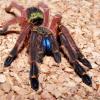Hello all,
A few days ago, my brother ('Bracchymyrmex') and I had a rather interesting encounter with a colony of what seemed to be Tapinoma sessile, or 'odorous house ants'. First, I notice a couple workers foraging around on an open patch of compact dirt outside of my garage; I snapped some photos and took a short video to include in an ID thread which unfortunately didn't receive too much love, but with some help from Nathan and Canadian Anter, I was able to identify the small black species as Tapinoma sessile.
Later that day, my brother and I decided to get some fresh air and explore out backyard with a little more attention than we had previously. We analyzed a small chunk of lumber I had put in our firewood pile, and found something pretty neat. I had noticed a few small, black Tapinoma sessile workers rummaging around near the wood, so I expected there was a decent chance of some activity under the bark. We lifted the bark, and found at least 150-200 workers freaking out and scattering their brood around the nest, so we panicked and tried desperately to locate a queen. After 5 or 10 minutes, we left the site unlucky and without a Tapinoma sessile colony or queen, so I found another small log with its bark still attached, and gently placed it over the spot where the previous one had been, in the hopes that they'd move in. I wasn't expecting it though, just being optimistic. I felt pretty bad that we disturbed the colony and I grew rather sad as we returned to the house, my head filled with the thought of a potentially injured queen and another traumatized innocent colony of ants.
I went out earlier today to check on how they were doing, to make sure we hadn't been the cause of any significant harm. To my surprise, I found myself in an essentially identical situation; I lifted up the bark of the log I had placed there previously and scrambled to find the queen before she had made a break for it. Astonishingly, despite my quicker reaction, I still couldn't find the queen! I went home, puzzled, and did a little research on this interesting species of particularly smelly ants.
After very little investigation, I quickly learned that this species is not only polygynous, with more than one queen, but it was polydomous as well. Ant colonies that exhibit polydomy establish branches from a 'mother' colony and create what are called 'satelite' nests to store & care for brood in more efficient and effective ways. Colonies that exhibit polydomy are also less susceptible to danger from predators, and the dispersion of their nests significantly decreases the chance of a queen being killed.
I reviewed a couple abstracts introducing the topic of polydomy, and how it plays a role in the evolution & production of a colony, but I couldn't access anything too in-depth pertaining to what I was interested in. I still have a some questions for any of you who have either experienced this, or are willing to share any insight.
- Does this satellite nest that I've encountered house a queen? How can I tell?
- Will the ants use this satellite nest as a port for male & female alates to take off from during nuptial flights? Can I come back here and expect anything in May, when T. sessile fly?
- How can I locate the 'mother' colony that this nest originated from?
Once again, if you have answers to any of these question or even just helpful insight you'd like to share, I would be very appreciative.
Thank you so much!
Edited by VoidElecent, April 12 2017 - 6:10 PM.

















